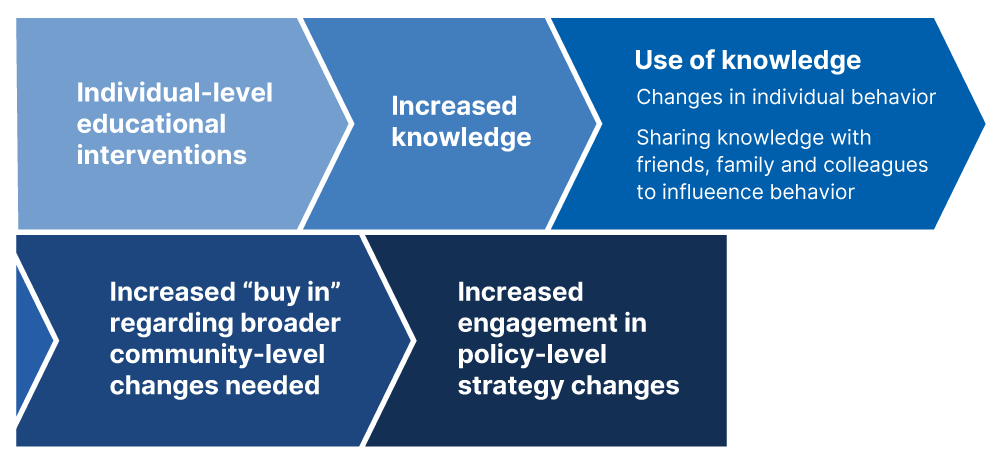Reducing Environmental and Occupational Cancer Risks Toolkit
Evidence-Informed Interventions
3. Support Individual-Level Risk Reduction
When considering environmental and occupational risk reduction strategies for your cancer plan, a useful place to start are interventions that focus on raising awareness and changing personal behaviors through education. Although education alone may not be sufficient to reduce exposures, the introduction of new concepts, new knowledge, and new practices, can over time and with repeated engagement, complement and build support for collective action and policy changes, as shown in the figure below.


Intervention Strategy Types: Encourage; Educate
Click here for more information from CDC about environmental/occupational exposure history practices and to download and share this form with health care professionals.
Health professionals are often not equipped to spot and support environmental and occupational cancer risk reduction needs among their patients. Practicing physicians only receive a few hours of training on environmental and occupational health risks during their medical education (Gehle et al. 2011). Although many in the nursing profession feel strongly that the environment is strongly linked to human health, surveys reveal they do not feel well-prepared to address the topic in practice (VonDongen 2002).
The use of exposure histories is an effective and useful resource to help healthcare providers target exposures or conditions of concern. A number of educational trainings and resources are available to support healthcare provider education interventions, including toolkits through the Agency for Toxic Substances Control (ATSDR) and toolkits designed for pediatricians, such as the Pediatric Environment Health Toolkit endorsed by the American Academy of Pediatrics.
Intervention Strategy Types: Encourage; Educate
Previous research has demonstrated:

Based on this research, the Silent Spring Institute developed the Detox Me app to support a person’s ability to reduce their exposure to toxic chemicals and thereby reduce their risk of cancer and other diseases. The app is based on research demonstrating cancer and other health risks associated with chemicals in consumer products and provides tips such as:
The Detox Me app also provides:
Additional apps are also noted in Module 2, including for example consumer purchasing apps such as Clearya and those developed by the Environmental Working group, such as Skin Deep.
Intervention Strategy Types: Encourage; Educate
 Worker education is critical to health and safety. Although employers are required by law to provide workers with access to safety data sheets to enhance knowledge about the chemical hazards used during their work processes, these resources do not provide easily understood information that informs workers about threats they face, including cancer risks. The GreenBlue Alliance, in collaboration with the U.S. Steelworkers, developed a “Putting Breast Cancer Out of Work” training that employs a “train-the-trainer” model for union leaders to repeat the training with members. The training explains the role of chemicals in breast cancer and other chronic diseases, the need for new policies that regulate chemical use, and provides examples of what cities, states, and leading companies are doing while new federal protections are pursued.
Worker education is critical to health and safety. Although employers are required by law to provide workers with access to safety data sheets to enhance knowledge about the chemical hazards used during their work processes, these resources do not provide easily understood information that informs workers about threats they face, including cancer risks. The GreenBlue Alliance, in collaboration with the U.S. Steelworkers, developed a “Putting Breast Cancer Out of Work” training that employs a “train-the-trainer” model for union leaders to repeat the training with members. The training explains the role of chemicals in breast cancer and other chronic diseases, the need for new policies that regulate chemical use, and provides examples of what cities, states, and leading companies are doing while new federal protections are pursued.
Intervention Strategy Types: Encourage; Educate

Several organizations nationally, including the Cancer and Environment Network of Southwest Pennsylvania have developed fact sheets to help educate and raise awareness about cancer risks found in homes and alternatives that can be used to avoid such risks. The fact sheet focuses on each room of the house, describes the inherent cancer risks, links to more information about the chemical of concern, and gives alternative product options to use instead. Although the fact sheet shared here was developed for cancer survivors, the information is about prevention and is useful to a range of target audiences.
Community-based environmental health partners active in cancer coalitions are often best suited to deliver these interventions, often in conjunction with other outreach efforts, including the use of community meetings and virtual events to enhance awareness of environmental health risks. Outreach strategies can also share resources with people and organizations engaged in building and renovating housing to equip them to consider sourcing safer. An excellent resource is HomeFree, developed by the Healthy Building Network to support identifying and using safer building products and materials.
Intervention Strategy Types: Encourage; Educate
City/land-use planning and design can affect a community’s cancer risk in a variety of ways including influencing physical activity, air quality, residential and industrial zoning, and access to healthy foods, parks, and open space (Wrey and Minaker, 2019). Moreover, the built environment can exacerbate disproportionate exposures that contribute to cancer inequities (Koohsari et al. 2021), including injustices such as living near facilities that emit toxicants or living near major traffic corridors. Planners and land use officials can design environments to reduce cancer risks associated with building products, near-roadway traffic exposures, and the permitting and citing of new economic development efforts to ensure appropriate setbacks from new industrial development to lessen the impact of hazardous emissions. Ensuring that urban design/land-use planners are aware of the underlying cancer burdens in their respective jurisdictions and are educated on best practices to “design out” cancer risks in our communities are critical intervention strategies to ensure that poor land-use designs which lead to poor health are not replicated moving forward.
